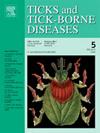A new hotspot of tick-borne encephalitis virus (TBEV) in the Autonomous Province of Trento, Italy
IF 3.4
2区 医学
Q2 INFECTIOUS DISEASES
引用次数: 0
Abstract
The tick-borne encephalitis virus (TBEV) has expanded its distributional range in Europe over recent decades. Italy is considered a low tick-borne encephalitis (TBE) incidence country, nonetheless, human cases have recently increased, reaching their maximum so far in 2022. This study reports on a new TBE hotspot in the Autonomous Province of Trento (Italy), along with a description of TBEV genetic variants at the provincial level. Tick sampling was performed where several TBE human cases were reported in 2022. As a result, 458 Ixodes ricinus ticks were collected (38 females, 49 males, 371 nymphs) and screened for TBEV through real-time PCR, pooling the nymphs while analyzing the adults individually. Eight samples were found to be positive for TBEV, corresponding to a 4.6 % prevalence in adults and a 1.1 % minimum infection rate in nymphs in the area. The identified TBEV genetic variants were compared with other TBEV European subtype (TBEV-Eu) strains. The relatively high prevalence in ticks and the reported human cases beyond the year of vector collection suggest a sustained virus circulation. Additionally, phylogenetic analysis of the genetic variants in the Trentino Province shows a separation among eastern and western sites. This study highlights the crucial importance of active surveillance for mitigating TBE risk, especially in highly anthropized Alpine areas.
意大利特伦托自治省蜱传脑炎病毒(TBEV)新热点
近几十年来,蜱传脑炎病毒(TBEV)在欧洲扩大了其分布范围。意大利被认为是低蜱传脑炎发病率的国家,然而,人间病例最近有所增加,在2022年达到迄今为止的最高水平。本研究报告了Trento自治省(意大利)的一个新的TBEV热点,以及省级TBEV遗传变异的描述。在2022年报告了几例TBE人间病例的地方进行了蜱虫取样。结果采集蓖麻蜱458只(雌蜱38只,雄蜱49只,雌雄蜱371只),采用实时荧光定量PCR技术进行TBEV检测,雌雄蜱集中,成虫单独分析。8个样本被发现为TBEV阳性,相当于该地区成人感染率为4.6%,若虫感染率最低为1.1%。将鉴定的TBEV遗传变异与其他TBEV欧洲亚型(TBEV- eu)进行比较。蜱虫中相对较高的流行率以及在媒介收集年份之后报告的人间病例表明存在持续的病毒传播。此外,对特伦蒂诺省遗传变异的系统发育分析表明,东部和西部位点存在分离。这项研究强调了主动监测对于降低TBE风险的重要性,特别是在高度人性化的高山地区。
本文章由计算机程序翻译,如有差异,请以英文原文为准。
求助全文
约1分钟内获得全文
求助全文
来源期刊

Ticks and Tick-borne Diseases
INFECTIOUS DISEASES-MICROBIOLOGY
CiteScore
6.90
自引率
12.50%
发文量
185
审稿时长
6-12 weeks
期刊介绍:
Ticks and Tick-borne Diseases is an international, peer-reviewed scientific journal. It publishes original research papers, short communications, state-of-the-art mini-reviews, letters to the editor, clinical-case studies, announcements of pertinent international meetings, and editorials.
The journal covers a broad spectrum and brings together various disciplines, for example, zoology, microbiology, molecular biology, genetics, mathematical modelling, veterinary and human medicine. Multidisciplinary approaches and the use of conventional and novel methods/methodologies (in the field and in the laboratory) are crucial for deeper understanding of the natural processes and human behaviour/activities that result in human or animal diseases and in economic effects of ticks and tick-borne pathogens. Such understanding is essential for management of tick populations and tick-borne diseases in an effective and environmentally acceptable manner.
 求助内容:
求助内容: 应助结果提醒方式:
应助结果提醒方式:


